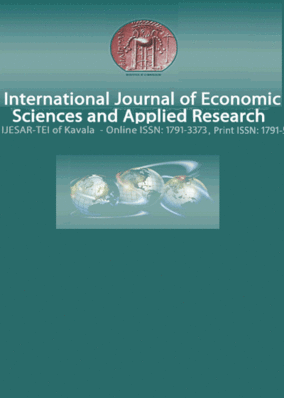Inflation and the great moderation : evidence from a large panel data set
Part of : International journal of economic sciences and applied research ; Vol.6, No.3, 2013, pages 7-19
Issue:
Pages:
7-19
Author:
Abstract:
This paper investigates the relationship between the Great Moderation and two measures of inflation performance: trend inflation and inflation volatility. Using annual data from 1970 to 2011 for a large panel of 180 developed and developing economies, the results show that, as expected, both measures are positively correlated with output volatility. When the two measures are jointly considered, however, and there is sufficient information to identify their effects separately, our empiricalfindings show that the effect of inflation volatility is positive, while the effect of trend inflation is negative. The implication is that reduced inflation volatility (holding trend inflation constant) helps stabilize the business cycle, whereas lower inflation (holding inflation volatility constant) exacerbates output volatility.
Subject (LC):
Keywords:
great moderation, trend inflation, inflation volatility
Notes:
Περιέχει πίνακες, εικόνες και βιβλιογραφία
References (1):
- Blanchard, O. and Simon, J., 2001, ‘The Long and Large Decline in U.S. Output Volatility’,Brookings Papers on Economic Activity, l,pp. 135-164.Carvalho, V. and Gabaix, X., 2013, ‘The Great Diversification and its Undoing ’, AmericanEconomic Review, 103, pp. 1697-1727.Coibion, O. and Gorodnichenko, Y., 2008, ‘Monetary Policy, Trend Inflation, and theGreat Moderation: An Alternative Interpretation’, NBER Working Paper No. 14621,December.Coibion, O. and Gorodnichenko, Y., 2011, ‘Monetary Policy, Trend Inflation, and the GreatModeration: An Alternative Interpretation’, American Economic Review, 101, pp. 341 -370.Hodrick, R.J. and Prescott, C.E., 1980, ‘Postwar U.S. Business Cycles: An EmpiricalInvestigation’, Discussion Paper 451, Carnegie Mellon University.Hodrick, R.J. and Prescott, C.E., 1997, ‘Postwar U.S. Business Cycles: An EmpiricalInvestigation’, Journal of Money, Credit, and Banking, 29, pp. 1-16.Gali, J. and Gambetti, L., 2009, On the Sources of the Great Moderation’, AmericanEconomic Journal: Macroeconomics, 1, pp. 26-57.Gozgor, G., 2013, ‘The New Keynesian Phillips Curve in an Inflation Targeting Country:The Case ofTurkey’, International Journal of Economic Sciences and Applied Research,6, 1, pp. 7-18.Keating, J. and Valcarcel, V., 2012, ‘Great Moderations’, Economics Letters, 115, pp. 168-171.Ravn, M.O. and Uhlig, H., 2002, On Adjusting the Hodrick-Prescott Filter for theFrequency of Observations’, Review of Economics and Statistics, 84, pp. 371-380.Stock, J. and Watson, M., 2002, ‘Has the Business Cycle Changes and Why?’, NBERWorking Paper No. 9127, September.Summers, M.P., 2005, ‘What Caused the Great Moderation? Some Cross CountryEvidence’, Federal Reserve Bank of Kansas City Economic Review, pp. 5-32.Vesselinov, R., 2012, ‘New Composite Indicators for Bulgarian Business Cycle’,International Journal of Economic Sciences and Applied Research, 5, pp. 101-111.




